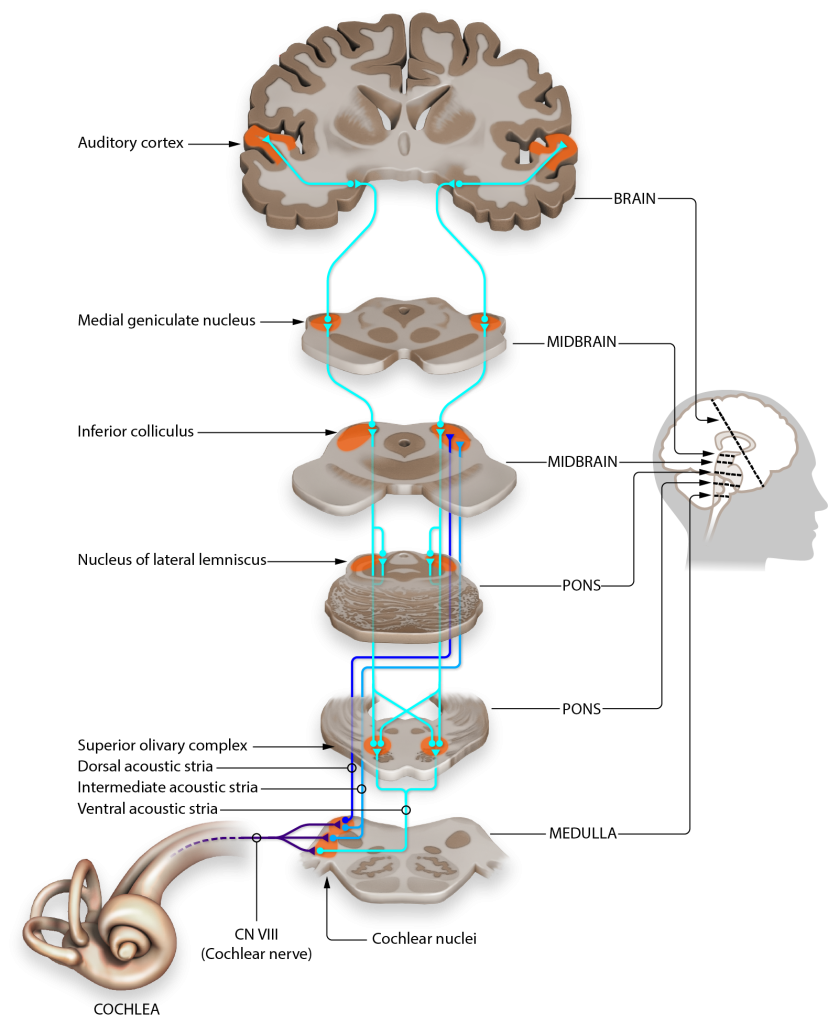Hearing Loss and Central Auditory Processing
50
Learning Objectives
Know the three different brainstem nuclei.
Understand the role of the medial geniculate nucleus.
A sensory pathway that carries peripheral sensations to the brain is referred to as an ascending pathway, or ascending tract. The sensory pathway of audition ascends through three brainstem nuclei. Audition begins by traveling along the vestibulocochlear nerve, which synapses with neurons in the cochlear nuclei of the superior medulla. The cochlear nuclei receives information from the cochlea. The input received in the cochlear nuclei is only from one side of the body.

(Provided by: Jonathan E. Peelle. License: CC BY 4.0)
The next part of the ascending process of auditory information in the brainstem is the superior olivary nucleus. The superior olivary nucleus takes the information from the cochlear nucleus and begins the process of interpreting and combing information. This begins the process of sound localization through estimating time difference and intensity between each ear (Christov, Nelson, & Gluth 2018).
After the superior olivary nucleus, auditory processing continues on to a nucleus called the inferior colliculus (IC). The inferior colliculus (IC) is a midbrain structure that integrates the vast majority of ascending auditory information and projects via the thalamus to the auditory cortex. The IC is also a point of convergence for corticofugal (information from the cerebral cortex) input and input originating outside the auditory pathway. Pathophysiological changes in the IC can alter all aspects of auditory perception and aid in localization of sound.
The medial geniculate nucleus of the thalamus then receives the auditory information from the three brainstem nuclei. The information is integrated and the medial geniculate nucleus projects that information to the auditory cortex in the temporal lobe of the cerebral cortex.
Additionally, feel free to take a look at this great video!
CC LICENSED CONTENT, SHARED PREVIOUSLY
OpenStax, Anatomy and Physiology Chapter 14.2 Central Processing
Provided by: Rice University.
Download for free at https://openstax.org/books/anatomy-and-physiology/pages/14-2-central-processing
License: CC Attribution 4.0
Adapted by: Nicole Engelhart
“Tinnitus-related changes in the inferior colliculus,” Joel I. Berger and Ben Coomber
Provided by: Frontiers in Neuroscience
URL: https://www.frontiersin.org/articles/10.3389/fneur.2015.00061/full
License: CC BY
Adapted by: Nicole Engelhart
References
Christov, F., Nelson, E. G., & Gluth, M. B. (2018). Human Superior Olivary Nucleus Neuron Populations in Subjects With Normal Hearing and Presbycusis. Annals of Otology, Rhinology & Laryngology, 127(8), 527-535.

